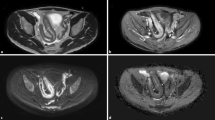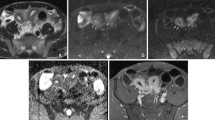Abstract
This review focuses specifically on the diagnostic value of T2-weighted imaging in the assessment of Crohn’s disease (CD) inflammation. In general, T2-weighted imaging has been less extensively investigated than T1-weighted gadolinium-enhanced imaging, even if it may offer similar information on disease activity. Furthermore, T2-weighted imaging allows CD characterization, which is crucial in the management of the disease when differentiating intestinal edema from fibrosis. Technical aspects, morphological findings and signs of active intestinal inflammation and fibrosis detectable on T2-weighted images will be reviewed and shown. Correlation between T2-weighted imaging findings, clinical activity indexes and histopathology features will be discussed. Since T2-weighted imaging is essential in the evaluation of CD activity, it should always complement with T1-weighted imaging, although it could also be used alone in the assessment of CD.







Similar content being viewed by others
References
Gasche C, Scholmerich J, Brynskov J, et al. (2000) A simple classification of Crohn’s disease: Report of the Working Party for the World Congresses of Gastroenterology 1998, Vienna. Inflamm Bowel Dis 6:8–15
Cosnes J, Cattan S, Blain A, et al. (2002) Long-term evolution of disease behavior of Crohn’s disease. Inflamm Bowel Dis 8:244–250
Louis E, Collard A, Oger A, et al. (2001) Behaviour of Crohn’s disease according to the Vienna classification: changing pattern over the course of the disease. Gut 49:777–782
Van Assche G, Geboes K, Rutgeerts P, et al. (2004) Medical therapy for Crohn’s disease strictures. Inflamm Bowel Dis 10:55–60
Maccioni F, Viscido A, Broglia L, et al. (2000) Evaluation of Crohn’s disease activity with MRI. Abdom Imaging 25:219–228
Low RN, Sebrechts CP, Politoske DA, et al. (2002) Crohn disease with endoscopic correlation: single shot fast spin echo and gadolinium enhanced fat-suppressed spoiled gradient-echo MR imaging. Radiology 222:652–660
Koh DM, Miao Y, Chinn RJ, et al. (2001) Imaging evaluation of the activity of Crohn’s disease. Am J Roentgenol 177(6):1325–1332
Ajaj WM, Lauenstein TC, Pelster G, et al. (2005) Magnetic resonance colonography for the detection of inflammatory diseases of the large bowel: quantifying the inflammatory activity. Gut 54:257–263
Maglinte DD, Gourtsoyiannis N, Rex D, et al. (2003) Classification of small bowel Crohn’s subtypes based on multimodality imaging. Radiol Clin N Am 41:285–303
Maccioni F, Viscido A, Marini M, Caprilli R (2002) MRI evaluation of Crohn’s disease of the small and large bowel with the use of negative superparamagnetic oral contrast agents. Abdom Imaging 27(4):384–393
Maccioni F, Bruni A, Viscido A, et al. (2006) MR imaging in patients with Crohn disease: value of T2- versus T1 weighted gadolinium-enhanced MR sequences with use of an oral superparamagnetic contrast agent. Radiology 238(2):517–530
Rimola J, Rodriguez S, García-Bosch O, et al. (2009) Magnetic resonance for assessment of disease activity and severity in ileocolonic Crohn’s disease. Gut 58(8):1113–1120
Rimola J, Ordás I, Rodriguez S, et al. (2011) Magnetic resonance imaging for evaluation of Crohn’s disease: validation of parameters of severity and quantitative index of activity. Inflamm Bowel Dis 17(8):1759–1768
Giovagnoni A, Fabbri A, Maccioni F (2002) Oral contrast agents in MRI of the gastrointestinal tract. Abdom Imaging 27(4):367–375
Gourtsoyiannis N, Papanikolau N, Grammatikakis J, Prassopoulus P (2002) MR enteroclysis: technical considerations, clinical applications. Eur Radiol 12(11):2651–2658
Laghi A, Borrelli O, Paolantonio P, et al. (2003) Contrast-enhanced magnetic resonance imaging of the terminal ileum in children with Crohn’s disease. Gut 52(2):393–397
Masselli G, Casciani E, Polettini E, et al. (2006) Assessment of Crohn’s disease in the small bowel: prospective comparison of magnetic resonance enteroclysis with conventional enteroclysis. Eur Radiol 16(12):2817–2827
Albert JG, Martiny F, Krummenerl A, et al. (2006) Diagnosis of small bowel Crohn’s disease: a prospective comparison of capsule endoscopy with magnetic resonance imaging and fluoroscopic enteroclysis. Gut 55(6):903
Borthne AS, Abdelnoor M, Rugtveit J, et al. (2006) Bowel magnetic resonance imaging of pediatric patients with oral mannitol MRI compared to endoscopy and intestinal ultrasound. Eur Radiol 16(8):1870
Gourtsoyiannis N, Papanikolaou N, Grammatikakis J, et al. (2001) MR enteroclysis protocol optimization: comparison between 3D FLASH with fat saturation after intravenous gadolinium injection and true FISP sequences. Eur Radiol 11(6):908–913
Madsen SM, Thomsen HS, Munkholm P, et al. (2002) Inflammatory bowel disease evaluated by low-field magnetic resonance imaging. Comparison with endoscopy, 99mTc-HMPAO leucocyte scintigraphy, conventional radiography and surgery. Scand J Gastroenterol 37(3):307–316
Holzknecht N, Helmberger T, Von Ritter C, et al. (1998) MRI of the small intestine with rapid MRI sequences in Crohn’s disease after enteroclysis with oral iron particles. Radiology 38(1):28–36 ((in alternative))
Umschaden HW, Szolar D, Gasser J, et al. (2000) Small-bowel disease: comparison of MR enteroclysis images with conventional enteroclysis and surgical findings. Radiology 215(3):639–641
Maccioni F (2010) Double-contrast magnetic resonance imaging of the small and large bowel: effectiveness in the evaluation of inflammatory bowel disease. Abdom Imaging 35(1):31–40
Gourtsoyianni S, Papanikolaou N, Amanakis E, et al. (2009) Crohn’s disease lymphadenopathy: MR imaging findings. Eur J Radiol 69(3):425–428
Lockhart-Mummery HE, Morson BC (1964) Crohn’s Disease of the large intestine. Gut 5:493–509
Morson BC (1968) Histopathology of Crohn’s disease. Proc R Soc Med 61:79–81
Chambers TJ, Morson BC (1979) The granuloma in Crohn’s disease. Gut 20:269–274
Geboes K (2008) What histologic features best differentiate Crohn’s disease from ulcerative colitis? Inflamm Bowel Dis 14(Suppl 2):S168–S169
Williams WJ (1964) Histology of Crohn’s disease syndrome. Gut 5:510–516
Graham MF, Diegelmann RF, Elson CO, et al. (1988) Collagen content and types in the intestinal strictures of Crohn’s disease. Gastroenterology 94:257–265
Burke JP, Mulsow JJ, O’Keane C (2007) Fibrogenesis in Crohn’s disease. Am J Gastroenterol 102(2):439–448
Gomes P, Du Boulay C, Smith CL, et al. (1986) Relationship between disease activity and colonoscopic findings in patients with colonic inflammatory bowel disease. Gut 27:92–95
Punwani S, Bainbridge M, Greenhalgh R, et al. (2009) Mural inflammation in Crohn disease: location-matched histologic validation of MR imaging features. Radiology 252(3):712–720
Hafeez R, Punwani S, Pendse D, et al. (2011) Derivation of a T2-weighted MRI total colonic inflammation score (TCIS) for assessment of patients with severe acute inflammatory colitis-a preliminary study. Eur Radiol 21(2):366–377
Fornasa F, Benassutti C, Benazzato L (2011) Role of Magnetic Resonance Enterography in differentiating between fibrotic and active inflammatory small bowel stenosis in patient with Crohn’s Disease. J Clin Imaging Sci 1(2):35
Horsthuis K, Bipat S, Stokkers PCF, et al. (2009) Magnetic resonance imaging for evaluation of disease activity in Crohn’s disease: a systematic review. Eur Radiol 19:1450–1460
Peyrin-Biroulet L, Gonzalez F, Dubuquoy L, et al. (2012) Mesenteric fat as a source of C reactive protein and as a target for bacterial translocation in Crohn’s disease. Gut 61(1):78–85
Meyers MA, McGuire PV (1995) Spiral CT demonstration of hypervascularity in Crohn disease: “vascular jejunization of the ileum” or the “comb sign”. Abdom Imaging 20:327–332
Madsen SM, Thomsen HS, Schlichting P, et al. (1999) Evaluation of treatment response in active Crohn’s disease by low-field magnetic resonance imaging. Abdom imaging 24(3):232–239
Author information
Authors and Affiliations
Corresponding author
Rights and permissions
About this article
Cite this article
Maccioni, F., Staltari, I., Pino, A.R. et al. Value of T2-weighted magnetic resonance imaging in the assessment of wall inflammation and fibrosis in Crohn’s disease. Abdom Imaging 37, 944–957 (2012). https://doi.org/10.1007/s00261-012-9853-y
Published:
Issue Date:
DOI: https://doi.org/10.1007/s00261-012-9853-y




